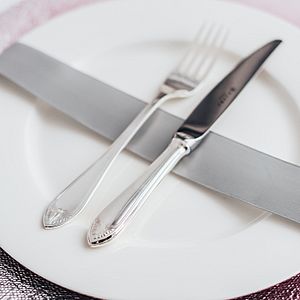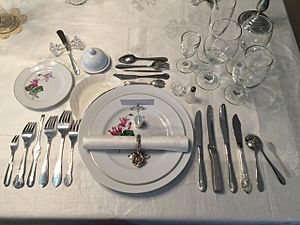Eating utensil etiquette facts for kids
Eating etiquette refers to the polite ways we use eating utensils and behave while having a meal. These customs can be very different depending on where you are in the world. For example, how you use a Fork in Europe is not the same as in the United States or Southeast Asia. These rules also change over time! In East Asian countries, there are special rules for using chopsticks.
Contents
Fork Etiquette Around the World
When you use a fork with a knife to cut and eat food in Western countries, there are two main ways people do it.
European Style Fork Use
In the European style, you keep the fork in your left hand. The knife stays in your right hand. You cut your food and then use the fork in your left hand to bring the food to your mouth. This style is often seen as faster because you don't switch hands.
American Style Fork Use
In the American style, also called the zig-zag method, you start with the knife in your right hand and the fork in your left. You hold the food with the fork (tines pointing down) and cut a bite-sized piece with the knife. Then, you put the knife down on your plate. You move the fork from your left hand to your right hand. Now, you use the fork in your right hand to bring the food to your mouth. After eating, you switch the fork back to your left hand and pick up the knife again to cut the next piece.
Some people think the American style is less efficient. Because of this, many people now use a mix of American and European styles. They might not switch the fork between hands. They might also use the fork with the tines pointing up, like a scoop, when it's easier.
German Style of Eating
The German style is a type of European style. You hold the fork (with the tines pointing down) in your left hand. The knife is in your right hand. After cutting a piece of food, you use the fork in your left hand to pick it up and eat it. For foods like potatoes or rice, you can use the knife blade to help guide the food onto the back of your fork. Both the knife and fork are held with the handle hidden in your palm, held by your thumb and pointer finger. This is sometimes called the "hidden handle" grip.
French Style of Eating
In France, forks are often placed on the table with the tines pointing down. This was done to show off the family's coat of arms, which was usually on the back of the fork. The knife goes in your right hand and the fork in your left. However, if you don't need a knife, like when eating pasta, you can hold the fork in your right hand. Bread is always served. It's not polite to use your fingers to taste food. But, it's okay to put a small piece of bread on the end of your fork to dip into a sauce before serving yourself.
Southeast Asian Style of Eating
In Southeast Asian countries, people mostly use a spoon. The spoon is held in the right hand during the whole meal. A fork is used only for certain dishes. Rice and soups are very common foods there, so using a spoon is very practical. The spoon helps move food around on the plate. Knives are rarely used because dishes are often cut into small pieces before they are cooked.
Table Setting Basics
Often, tables are set with more than one fork. Each fork is for a different part of the meal. For example, there might be a fork for salad, a fork for meat, and a fork for dessert. Some fancy places might put out many forks for a big meal with many courses. However, many etiquette experts think it's better to bring out the right fork with each new course.
In American dining rules, how you place your utensils on the plate tells the waiting staff if you are still eating or if you have finished.
Cutlery Placement After Eating
In the United States, when you are done eating, you can place all your utensils together on your plate. Imagine your plate is a clock. You would place them pointing towards the "4-o'clock" position. This tells the staff that you have finished your meal and they can take your plate away.
Chopstick Etiquette
Rules for using chopsticks are similar in many Asian regions, but some small things can be different. In some cultures, it's considered rude to point at things with your chopsticks. It's also impolite to leave your chopsticks standing upright in a bowl. This is because leaving chopsticks standing in a bowl can look like offerings made to people who have passed away.



